Blog Archives
What Happened Today at the Monastery?

We began a bright new phase today with news at lunch from the Lambodara Kulam. It appears we may have as many as 3 priests coming for the Garbanyasa ceremonies during Guru Purnima.

Our Sun One Homa….
Someone asked what the “Garbanyasa” ceremony signifies. “Garba” means womb and this ceremony is usually done near the half-way point in the cycle of the temple’s manifestation, which is now.

The Garbanyasa ceremony is likened to the quickening of the fetus inside the mother… the first time the baby kicks and is felt moving. So this will be that time for the “baby Iraivan.”

Shailaja and Nat, to be married on Sunday on Kauai, were our guests at this morning’s homa. Congratulations to you both! Shailaja’s mother had organised the visit to the temple so that the young couple would get Bodhinatha’s blessing before the wedding.

Shailaja and Nat, both teachers, live and work in California.

Here’s part of the wedding party who were present at the homa.
Saiva Siddhanta Church — Sri Lanka

We are happy to bring you news from our spiritual homeland in Sri Lanka… Rishi Thondunatha sends these photos and captions of the consecration of the reconstructed Siva Shrine in Kopay.
“The Sri Subramuniya Kottam is an institution established by Gurudeva. It’s main purpose is to provide religious and secular education to the youth of the surrounding villages. As an outgrowth of the Kottam, the Shanti Lingam Temple came in existence 22 years ago. In fact the original structure of the inner sanctum that houses the Shanti Lingam was erected almost entirely by the young students at the Kottam. Only one professional mason was hired. He oversaw the work of the youth as they cemented the temple with him brick by brick with their young hands. Then on January 5th 1983, on Gurudeva’s 56th birthday he placed Shanti Lingam in the temple constructed by the youth with his own hands.

“Since then, the temple has been serving devotees in Kopay through all of the trials and tribulations that the island goes through. It is only by Gurudeva’s grace that the temple continues to exist and be of service all this day.”
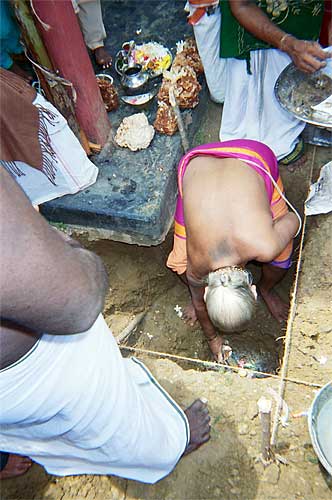
“Shanti Lingam temple has been keeping Gurudeva’s name and presence alive in Jaffna.

People who come and worship there are constantly reminded of Gurudeva, by the very fact that he brought the Siva Lingam from Kauai Aadheenam and ceremoniously placed it in the sanctum.”
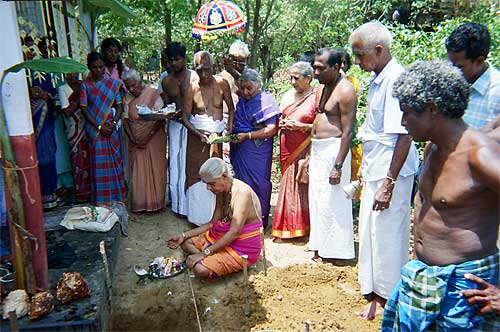
However during the war in 1996 the temple’s mandapam roof in front of the shrine was damaged. It was deteriorating since. For fear of possible collapse of the roof and the safety of the devotees, Sri Subramuniya Kottam decided to rebuild it.
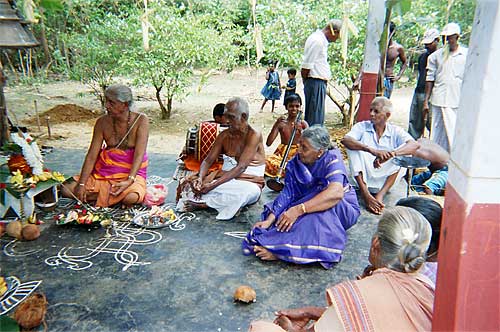
A professional construction firm, Manoharan and Vettivel Constructors, in Jaffna was hired. With the first donation given by Satguru Bodhinatha the reconstruction commenced on April 10, 2005. The stone laying ceremony was held on this day. Currently the construction is moving along smoothly.
Himalayan Acres Developments
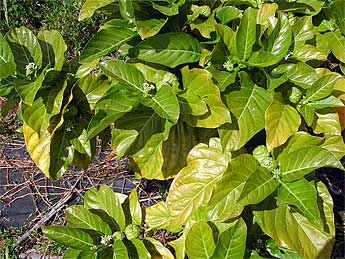
Happy noni plants are growing strongly on Himalayan Acres.

We are harvesting already about ten pounds of fruit a week from the 40 or so two-year-old plants. Noni is a native Hawaiian medicinal fruit and well adapted to our soil. Of course, so is the guinea grass you see growing between the rows!
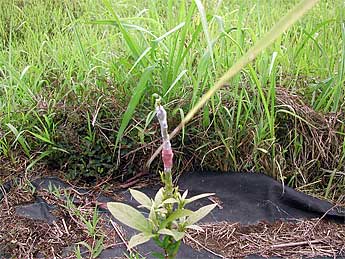
Four weeks ago we grafted about 60 avocado trees which had been planted about 18 months ago from seed. It’s difficult to see, but the little bud at the very top of this plant shows the graft has taken. The new growth below the bud is removed to force the tree to put all its energy into the graft. Amazingly, given our lack of experience, 55 of the 60 grafts had taken, and of the five that failed, two had been knocked off, likely by wild pigs.
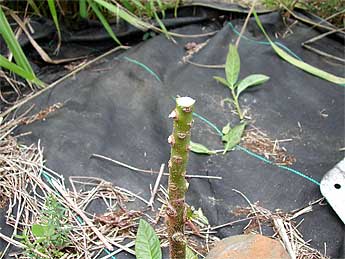
Grafting the young avocado starts rather drastically, cutting it off completely about a foot from the ground.
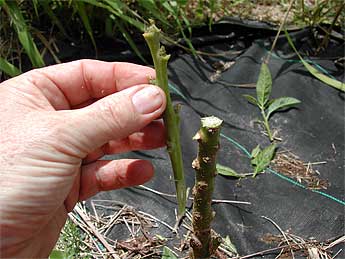
The piece at left is the “scion” wood, a branch from an avocado tree of the right type, in this case “green gold.” Avocados do not grow true to type from seed and are always grafted.
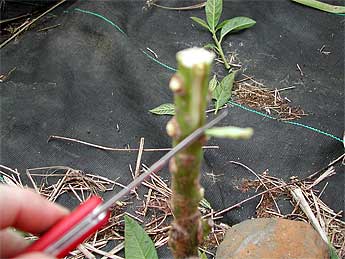
Sorry for the blurry photo, as the camera didn’t know what to focus on. This shows the cutting away of the bark for a side veneer graft.
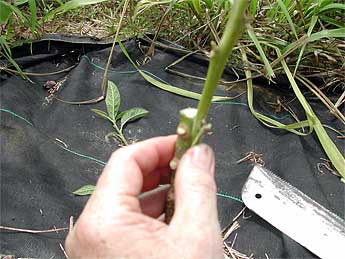
The scion is cut wedge shaped and placed inside the flap of bark.
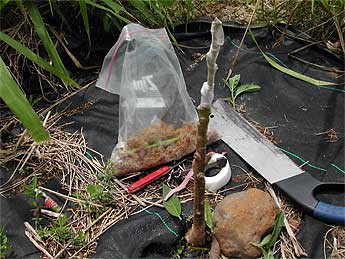
It is then wrapped in parafilm, a paraffin wax product recommended to us by Satya Palani. In the back you see the bag of scion pieces, kept moist with peat moss, the cutting saw, grafting knife, rubber band and par
afilm wax.
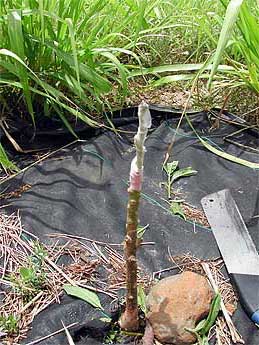
The last step is to tightly wrap the graft with a strip of rubber band to hold it together. Over the coming weeks, both parafilm wax and the band will deteriorate and fall off the plant, leaving the graft to grow.
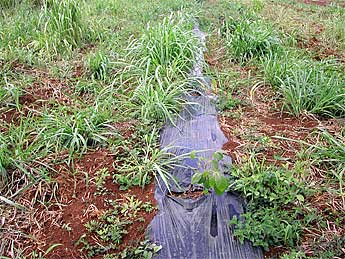
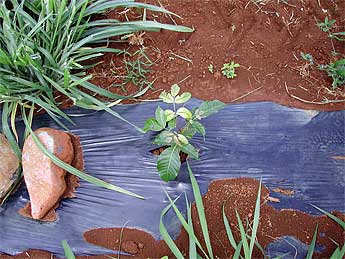
Not much to see, but this Honduran mahogany tree is actually doing quite well. Several hundred of these were planted a few months ago and are doing well despite our lack of rain.
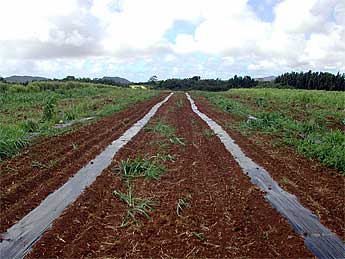
Sadhaka Adinatha laid up two more strips of mulch for more tree planting. We’ve switched to four foot wide mulch from the three foot, which didn’t keep the weeds far enough away.

This shows a strip of ironwoods, just nine months old or so, at the left of the picture. Many are not five feet high. We’ve seen several of our stands of ironwoods, planted for windbreaks, double in height in a matter of months.

This is a red cedar tree which was planted in January and has really gotten off to a good start. Red cedar is a fast growing tree, with a medium value wood. It is part of a test plot to see what trees grow happily here.

This is a less-than-happy teak tree, which seems to want to grow a fat stump while remaining close to the ground–bad strategy in an area which the weeds hit several feet high easily.
From Our Gurus' Teachings
Archives are now available through 2001. Light colored days have no posts. 1998-2001 coming later.
